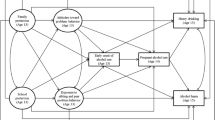Abstract
Using data from the National Longitudinal Study Youth Survey (NLSY), runaway status in early adolescence (ages 14–15) was associated with subsequent (four years later) substance abuse, alcohol problems, and school dropout status. Three runaway categories were formed—never runaway, runaway once, and runaway two or more times. Overall, the repeat runaways reported engaging in higher levels of substance use and abuse than never and once runaways. However, some degree of gender specificity in the relationships for repeat runaways and substance abuse was found. Female repeat runaways were particularly susceptible to abusing illicit drugs (and not acoohol), whereas male repeat runaways manifested a more generalized susceptability to abusing alcohol, cigarettes, marijuana, and other illicit drugs. Whereas substance use and abuse were linearly associated with runaway status, both the one-time and repeat runaways manifested equivalent proportions of school dropouts, and at levels far exceeding never runaways. Results are discussed with regard to the heterogeneous developmental pathways leading toward and away from adolescent runaways.
Similar content being viewed by others
References
Adams, G. R., and Munro, G. (1979). Portrait of the North American runaway: A critical review.J. Youth Adoles. 8: 359–373.
Bock, R. D., and Moore, E. G. J. (1986).advantage and Disadvantage: A Profile of American Youth. Lawrence Erlbaum, Hillsdale, NJ.
Brennan, T., Huizinga, D., and Elliott, D. S. (1978).The Social Psychology of Runaways. D. C. Heath, Boston.
Ensminger, M. E., Brown, C. H., and Kellam, S. G. (1982). Sex differences in antecedents of substance use among adolescents.J. Social Issues 38: 25–42.
Hays, R. D., and Huba, G. J. (1988). Reliability and validity of drug use items differing in the nature of their response options.J. Consult. Clin. Psychol. 56: 470–472.
Huba, G. J. (1983). Cross-validation of a drug use causal model in the Columbia Longitudinal Study data.Bull. Society Psychol. Addict. Behav. 2: 128–132.
Janus, M. D., McCormack, A., Burgess, A. W., and Hartman, C. (1987).Adolescent Runaways: Causes and Consequences. D. C. Heath, Lexington, MA.
Jessor, R., and Jessor, S. L. (1977).Problem Behavior and Psychosocial Development: A Longitudinal Study of Youth. Academic Press, New York.
Loeber, R., Weissman, W., and Reid, J. B. (1983). Family interactions of assaultive adolescents, stealers and nondelinquents.J. Abnorm. Child Psychol. 11: 1–4.
National Institute of Education, Washington, DC. (1979). Office of Smoking and Health, Rockville, MD, and Bureau of Health Education, CDC.
Olson, L., Liebow, E., Mannino, F. V., and Shore, M. F. (1980). Runaway children twelve years later: A follow-up.J. Family Issues 1: 165–188.
Rachal, J. V., Guess, L. L., Hubbard, R. L., Maisto, S. A., Cavanaugh, E. R., Waddell, R., and Benrud, C. H. (1980).Adolescent Drinking Behavior, Vol. I: The Extent and Nature of Adolescent Alcohol and Drug Use: The 1974 and 1978 National Sample Studies. Research Triangle Institute, Research Triangle Park.
Robins, L. N., and O'Neal, P. (1959). The adult prognosis for runaway children.Am. J. Orthopsychiatry. 29: 752–761.
Rosenberg, M. (1965).Society and the Adolescent Self-Image. Princeton University Press, Princeton, NJ.
Thompson, K. M., and Wilsnack, R. W. (1984). Drinking and drinking problems among female adolescents: Patterns and influences. In Wilsnack, S. C., and Beckman, L. J. (eds.),Alcohol Problems in Women. Guilford Press, New York.
Wanberg, K. W., and Horn, J. L. (1970). Alcoholism symptom patterns of men and women: A comparative study.Quart. J. Studies Alcohol 31: 40–61.
Weisberg, D. K. (1985).Children of the Night. D. C. Heath, Lexington, MA.
Winokur, G., and Clayton, P. (1968). Family history studies. IV. Comparison of male and female alcoholics.Quart. J. Stud. Alcohol 29: 885–891.
Yates, G. L., MacKenzie, R., Pennbridge, J., and Cohen, E. (1988). A risk profile comparison of runaway and non-runaway youth.Am. J. Public Health 78: 820–821.
Young, R. L., Godfrey, W., Matthews, B., and Adams, G. R. (1983). Runaways: A review of negative consequences.Family Relations 32: 275–281.
Author information
Authors and Affiliations
Additional information
Dr. Windle's major research interests involve the identification of high risk factors and then influences on adolescent substance use and other problem behaviors.
Rights and permissions
About this article
Cite this article
Windle, M. Substance use and abuse among adolescent runaways: A four-year follow-up study. J Youth Adolescence 18, 331–344 (1988). https://doi.org/10.1007/BF02139253
Received:
Accepted:
Issue Date:
DOI: https://doi.org/10.1007/BF02139253




